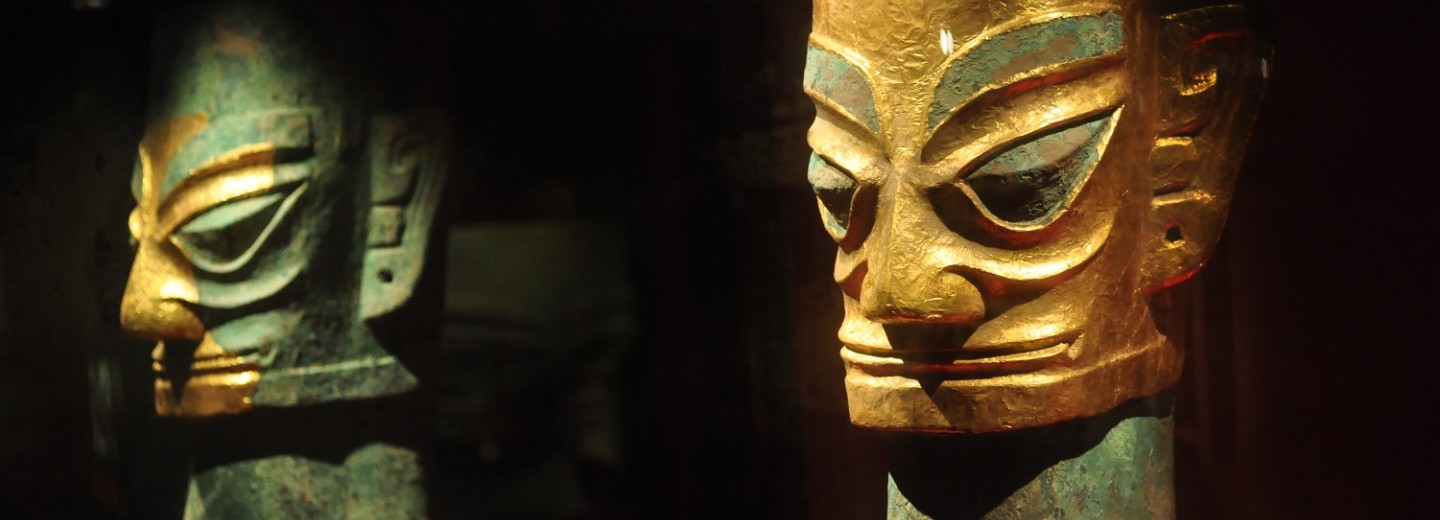Archaeology in Sichuan
Background
In the spring of 1929, farmer Yan Daocheng accidentally discovered a pit of jade tools while scouring a ditch. Among them were about three to four hundred ancient jade rings and stone beads. He did not know at the time, but this accidental discovery revealed an ancient and mysterious civilization.
DC Graham, curator of the Museum of Concord University of the West, conducted the first archaeological excavation and discovered more than 300 pottery and jade objects, some of which are now in the Sichuan University Museum. In 1950, during the construction of the Chengdu-Chongqing Railway, many cultural relics were dug up along the railway. The most important excavation in Sanxingdui was launched in 1986. The Sichuan Provincial Cultural Relics Management Committee and related units conducted large-scale excavations of the site.

The Sanxingdui site is about 40 kilometres north of Chengdu City. It has a total area of 12 square kilometres. It is the largest ancient Shu cultural site in China. The age of the Sanxingdui site is from 2800 BC to 1100 BC, which is approximately equivalent to the Xia, Shang and Zhou periods in the Central Plains.
What is different about the Sanxingdui site?

According to Professor Chen Xiandan, the former deputy dean of the Sichuan Provincial Institute of Cultural Relics and Archaeology, Sanxingdui bronzes can be summarized in four words: tall, big, strange, and special. They are mainly divided into ritual vessels, honour guards, bronze figures, heads, masks, and other figures. Animal and plant shapes, sun-shaped devices, eye-shaped devices, temples, insects, seashells, bronze, and other vessel shapes. The exquisite craftsmanship of bronze modelling includes advanced techniques like painting, clay sculpture, re-moulding, smelting, casting, and polishing. The techniques are clean and neat, the markings are clear. The most concise outlines show realistic and emotionally complex characters.
The newly unearthed golden mask in Sanxingdui is alleged to be very similar to another mask unearthed at the Jinsha site.
Due to the lack of obvious connection between these cultural relics and Chinese culture, and the fact no one can decipher the symbols on them, there are many disputes about the purpose of these relics.
Judging from the large number of artifacts found at the Sanxingdui site, this unknown civilization once had a prosperous economy and advanced technology. After becoming the granary that helped the First Emperor (Qin) build China’s first centralized empire, Sichuan officially became a part of Chinese civilization, Due to the lack of written records, its early history is still shrouded in mystery.

The deputy director of the State Administration of Cultural Heritage of China said that the excavation of the Sanxingdui site is one of the major “Archaeological China” projects of the State Administration of Cultural Heritage. The project aims to answer some big question in Chinese history and better understand the formation of Chinese civilization.
Because Sanxingdui is located on the border of the Central Plains, many of the unearthed cultural relics are very different from the archaeological discoveries of the Central Plains in appearance and artistic style. The human-shaped bronze statues unearthed in Sanxingdui do not look like humans in appearance. Therefore, some people imagine that the Sanxingdui civilization was an alien civilization.
The Sanxingdui civilization is not an alien civilization, say scholars and academics. This civilization was developed in Sichuan based on the local prehistoric neolithic culture. It also absorbed many cultural factors from other regions, including the lower reaches of the Yangtze River, the north-western region, and the culture of the Central Plains. Sichuan did not become part of the Chinese civilization until the Qin and Han dynasties and so had developed differently.
Cultural debate
Whatever scientists may eventually conclude, these artifacts open a big debate about what it means to be Chinese. Professor Ge Zhaoguang believes that a historical foundation is important. However, relying solely on long history is not enough to prove who “we” are. ‘As the Chinese “we”, we have never been singular, but highly mixed and heterogeneous.’ The nation is a hybrid, which is very respectable. However, today’s Chinese people still seem to have a taboo about being hybrid.
The fresh, remarkable, discoveries in Sanxingdui make it clear that being Chinese did not originate from one source, ethic group, civilisation, or people. The single doctrine of Confucianism alone could not support the sole culture of China. Confucius had never been abroad. He had never seen a great deal that was commonplace elsewhere. How can it be said that Confucianism is the sole representative of this family? That is why Buddhism is found in Chinese tradition, including Zoroastrianism, Manichaeism, and Nestorianism.

Many Western regions of China gradually integrated into the rest of China during the Mongol and Yuan Dynasties and learned the Han culture. However, there were also many other exchanges at that time. After intermarriage and communication, many Han people also blended into the blood of foreigners. Equally, during the early period of the Mongolian Yuan Dynasty, many Han people also integrated into Mongolia.
The Professor concludes that there are three elements of cultural identity and cultural belonging. First, we must admit that the people once had a common historical origin and cultural tradition; second, we must admit that these people are now different from “other people”; finally, the differences are not ethnic differences but cultural differences. In the end, people believe in sharing values with each other and believe that they will follow a common path in the future, so they must work together on this path.
Do not ask: “Where do I come from?” What needs to be asked is what makes people feel at ease, what makes this land “home”, what makes people “return”, and ultimately “they” become “us”.
The discoveries at Sanxingdui and their analysis, may yet have a powerful effect on the understanding of Chinese history and culture. More than that, reviewing more diligently how we understand cultures and origins in other parts of the world may help reduce the scourge of global racism.
Worked on the article:

Wanlikhang





